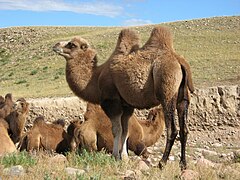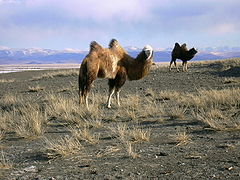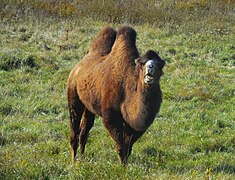
A camel is an even-toed ungulate in the genus Camelus that bears distinctive fatty deposits known as "humps" on its back. Camels have long been domesticated and, as livestock, they provide food and textiles. Camels are working animals especially suited to their desert habitat and are a vital means of transport for passengers and cargo. There are three surviving species of camel. The one-humped dromedary makes up 94% of the world's camel population, and the two-humped Bactrian camel makes up 6%. The wild Bactrian camel is a distinct species that is not ancestral to the domestic Bactrian camel, and is now critically endangered, with less than 1,000 individuals.

The llama is a domesticated South American camelid, widely used as a meat and pack animal by Andean cultures since the pre-Columbian era.
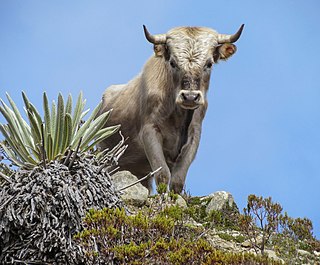
A feral animal or plant is one that lives in the wild but is descended from domesticated individuals. As with an introduced species, the introduction of feral animals or plants to non-native regions may disrupt ecosystems and has, in some cases, contributed to extinction of indigenous species. The removal of feral species is a major focus of island restoration.

Camelids are members of the biological family Camelidae, the only currently living family in the suborder Tylopoda. The seven extant members of this group are: dromedary camels, Bactrian camels, wild Bactrian camels, llamas, alpacas, vicuñas, and guanacos. Camelids are even-toed ungulates classified in the order Artiodactyla, along with species including whales, pigs, deer, cattle, and antelopes.

The dromedary, also known as the dromedary camel, Arabian camel, or one-humped camel, is a large even-toed ungulate, of the genus Camelus, with one hump on its back.

Lama is a genus containing the extant South American camelids: the wild guanaco and vicuña and the domesticated llama, alpaca, and chilihueque. Before the Spanish conquest of the Americas, llamas, alpacas, and chilihueques were the only domesticated ungulates of the continent. They were kept not only for their value as beasts of burden, but also for their flesh, hides, and wool.
A cama is a hybrid between a male dromedary camel and a female llama, and has been produced via artificial insemination at the Camel Reproduction Centre in Dubai. The first cama was born on January 14, 1998. The aim was to create an animal capable of higher wool production than the llama, with the size and strength of a camel and a cooperative temperament.

Camelops is an extinct genus of camels that lived in North and Central America, ranging from Alaska to Honduras, from the middle Pliocene to the end of the Pleistocene. It is more closely related to the Old World dromedary and bactrian and wild bactrian camels than to the New World guanaco, vicuña, alpaca and llama; making it a true camel of the Camelini tribe. Its name is derived from the Ancient Greek κάμηλος and ὄψ, i.e. "camel-face".

Camel milk is milk from female camels. It has supported nomad and pastoral cultures since the domestication of camels millennia ago. Herders may for periods survive solely on the milk when taking the camels on long distances to graze in desert and arid environments, especially in parts of the Middle East, North Africa and the Horn of Africa. The camel dairy farming industry has grown in Australia and the United States, as an environmentally friendly alternative to cow dairy farming using a species well-adapted to arid regions.

The alpaca is a species of South American camelid mammal. It is similar to, and often confused with, the llama. However, alpacas are often noticeably smaller than llamas. The two animals are closely related and can successfully crossbreed. Both species are believed to have been domesticated from their wild relatives, the vicuña and guanaco. There are two breeds of alpaca: the Suri alpaca and the Huacaya alpaca.
Interspecific pregnancy is the pregnancy involving an embryo or fetus belonging to another species than the carrier. Strictly, it excludes the situation where the fetus is a hybrid of the carrier and another species, thereby excluding the possibility that the carrier is the biological mother of the offspring. Strictly, interspecific pregnancy is also distinguished from endoparasitism, where parasite offspring grow inside the organism of another species, not necessarily in the womb.
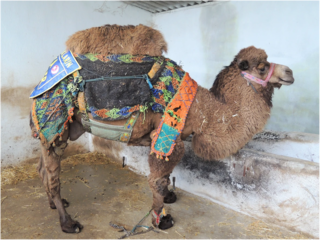
The hybrid camel is a domestic camelid hybrid between a Bactrian camel and dromedary. It is the offspring of a male Bactrian camel and a female dromedary.
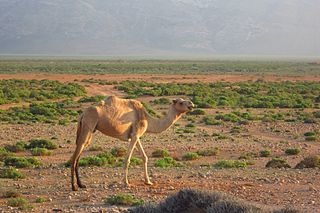
Camel urine is a liquid by-product of metabolism in a camel's anatomy. Urine from camels has been used in prophetic medicine for centuries, being a part of ancient Bedouin practices and also Muslim tradition. According to the World Health Organization, the use of camel urine as a medicine lacks scientific evidence. After the spread of MERS-CoV infections, the WHO urged people to refrain from drinking "raw camel milk or camel urine or eating meat that has not been properly cooked".

The wild Bactrian camel is a critically endangered species of camel living in parts of northwestern China and southwestern Mongolia. It is closely related but not ancestral to the domestic Bactrian camel. Genetic studies have established it as a separate species which diverged from the Bactrian camel about 0.7-1.1 million years ago.

Betacoronavirus is one of four genera of coronaviruses. Member viruses are enveloped, positive-strand RNA viruses that infect mammals, including humans. The natural reservoir for betacoronaviruses are bats and rodents. Rodents are the reservoir for the subgenus Embecovirus, while bats are the reservoir for the other subgenera.
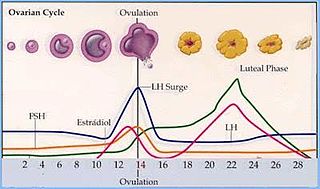
Induced ovulation is when a female animal ovulates due to an externally-derived stimulus during, or just prior to, mating, rather than ovulating cyclically or spontaneously. Stimuli causing induced ovulation include the physical act of coitus or mechanical stimulation simulating this, sperm and pheromones.
Camelus thomasi is an extinct species of camel from the Early-Mid Pleistocene of North Africa. It is known primarily from Tighennif (Ternifine) in Algeria. Fossils from northern Sudan and Israel dated to the Late Pleistocene have been included under C. thomasi, but they are now considered to belong to different species, making C. thomasi a strictly Northwest African species.
features. Some studies have linked it as a possible ancestor to the dromedary, while others suggest it may be more closely related to the Bactrian camel of central Asia. However, a 2018 study revealed such assertions to be lacking any scientific basis, and C. thomasi appears to not be closely related to any living camel.
Camelus knoblochi is an extinct species of camel from the Pleistocene. One of the largest known camel species, its range spanned from Eastern Europe to Northern China.










